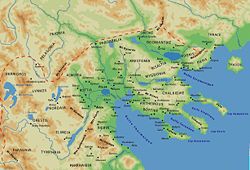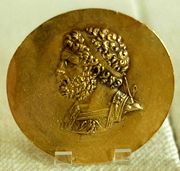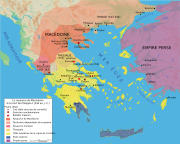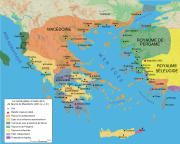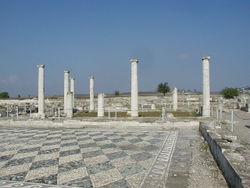Macedon
2008/9 Schools Wikipedia Selection. Related subjects: Ancient History, Classical History and Mythology; European Geography
|
|||||||||||||||||||||||||||||||||||||
Macedon or Macedonia (Greek Μακεδονία Makedonía) was the name of a kingdom centered in the northern-most part of ancient Greece, bordered by the kingdom of Epirus to the west and the region of Thrace to the east. For a brief period it became the most powerful state in the ancient Near East after Alexander the Great conquered most of the known world, inaugurating the Hellenistic period of world history.
History
Early history
The first Macedonian state emerged in the 8th or early 7th century BC under the Argead Dynasty, who according to legend, migrated to the region from the Greek city of Argos in Peloponnesus (thus the name Argead). It should be mentioned that the Macedonian tribe ruled by the Argeads, the tribe whose lands the Greeks called Macedonia, was itself called Argead (which translates as "descended from Argos"). Its first king is recorded as Perdiccas I. The kingdom was situated in the fertile alluvial plain, watered by the rivers Haliacmon and Axius, called Lower Macedonia, north of the mountain Olympus. Around the time of Alexander I of Macedon, the Argead Macedonians started to expand into Upper Macedonia, that is Eordaia, Bottiaea, Mygdonia, and Almopia- which were mountainous regions settled by independent Macedonian tribes. Near the modern city of Veria, Perdiccas I (or, more likely, his son, Argaeus I) built his capital, Aigai (modern Vergina). After a brief period under Persian rule under Darius Hystaspes, the state regained its independence under King Alexander I ( 495– 450 BC).
Atticisation and expansion
Prior to the 4th century BC, the kingdom covered a region approximately corresponding to the province of Macedonia of modern Greece. It became increasingly Atticised during this period, though prominent Athenians appear to have regarded the Macedonians as uncouth.
A unified Macedonian state was eventually established by King Amyntas III (c. 393– 370 BC), though it still retained strong contrasts between the cattle-rich coastal plain and the fierce isolated tribal hinterland, allied to the king by marriage ties. They controlled the passes through which barbarian invasions came from Illyria to the north and northwest. Amyntas had three sons; the first two, Alexander II and Perdiccas III reigned only briefly. Perdiccas III's infant heir was deposed by Amyntas' third son, Philip II of Macedon, who made himself king and ushered in a period of Macedonian dominance of Greece.
Under Philip II, ( 359– 336 BC), Macedon expanded into the territory of the Paionians, Thracians, and Illyrians. Among other conquests, he annexed the regions of Pelagonia and Southern Paionia.
Macedon became more politically involved with the south-central city-states of Ancient Greece, but it also retained more archaic features like the palace-culture, first at Aegae (modern Vergina) then at Pella, resembling Mycenaean culture more than classic Hellenic city-states, and other archaic customs, like Philip's multiple wives in addition to his Epirote queen Olympias, mother of Alexander.
Another archaic remnant was the very persistence of a hereditary monarchy which wielded formidable – sometimes absolute – power, although this was at times checked by the landed aristocracy, and often disturbed by power struggles within the royal family itself. This contrasted sharply with the Greek cultures further south, where the ubiquitous city-states mostly possessed aristocratic or democratic institutions; the de facto monarchy of tyrants, in which heredity was usually more of an ambition rather than the accepted rule; and the limited, predominantly military and sacerdotal, power of the twin hereditary Spartan kings. The same might have held true of feudal institutions like serfdom, which may have persisted in Macedon well into historical times. Such institutions were abolished by city-states well before Macedon's rise (most notably by the Athenian legislator Solon's famous σεισάχθεια seisachtheia laws).
Empire
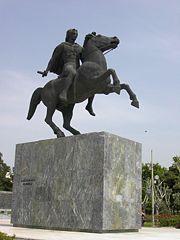
Philip's son Alexander the Great ( 356– 323 BC) managed to briefly extend Macedonian power not only over the central Greek city-states, but also to the Persian empire, including Egypt and lands as far east as the fringes of India. Alexander's adoption of the styles of government of the conquered territories was accompanied by the spread of Greek culture and learning through his vast empire. Although the empire fractured into multiple Hellenic regimes shortly after his death, his conquests left a lasting legacy, not least in the new Greek-speaking cities founded across Persia's western territories, heralding the Hellenistic period. In the partition of Alexander's empire among the Diadochi, Macedonia fell to the Antipatrid dynasty, which was overthrown by the Antigonid dynasty after only a few years, in 294 BC.
Hellenistic Macedonia
Antipater and his son Cassander gained control of Macedonia but it slid into a long period of civil strife following Cassander's death in 297 BC. It was ruled for a while by Demetrius I ( 294– 288 BC) but fell into civil war.
Demetrius' son Antigonus II ( 277– 239 BC) defeated a Galatian invasion as a condottiere, and regained his family's position in Macedonia; he successfully restored order and prosperity there, though he lost control of many of the Greek city-states. He established a stable monarchy under the Antigonid dynasty. Antigonus III ( 239– 221 BC) built on these gains by re-establishing Macedonian power across the region.
What is notable about the Macedonian regime during the Hellenistic times is that it was the only successor state to the Empire that maintained the old archaic perception of Kingship, and never adopted the ways of the Hellenistic Monarchy. Thus the king was never deified in the same way that Ptolemies and Seleucids were in Egypt and Asia respectively, and never adopted the custom of Proskynesis. The ancient Macedonians during the Hellenistic times were still addressing their kings in a far more casual way than the subjects of the rest of the Diadochi, and the Kings were still consulting with their aristocracy (Philoi) in the process of making their decisions.
Conflict with Rome
Under Philip V of Macedon ( 221– 179 BC) and his son Perseus of Macedon ( 179– 168 BC), the kingdom clashed with the rising power of the Roman Republic. During the 2nd and 1st centuries BC, Macedon fought a series of wars with Rome. Two major losses that led to their inevitable defeat were in 197 BC when Rome defeated Philip V, and 168 BC when Rome defeated Perseus. The overall losses resulted in the defeat of Macedon, the deposition of the Antigonid dynasty and the dismantling of the Macedonian kingdom. Andriscus' brief success at reestablishing the monarchy in 149 BC was quickly followed by his defeat the following year and the establishment of direct Roman rule and the organization of Macedon as the Roman province of Macedonia.
Institutions
The political organization of the Macedonian kingdom was a three-level pyramid: on the top, the King and the nation, at the foot, the civic organizations (cities and éthnē), and between the two, the districts. The study of these different institutions has been considerably renewed thanks to epigraphy, which has given us the possibility to reread the indications given us by ancient literary sources such as Livy and Polybius. They show that the Macedonian institutions were near to those of the Greek federal states, like the Aetolian and Achaean leagues, whose unity was reinforced by the presence of the king.
The King
The king ( Βασιλεύς, Basileús) headed the central administration: he led the kingdom from its capital, Pella, and in his royal palace was conserved the state's archive. He was helped in carrying out his work by the Royal Secretary (βασιλικὸς γραμματεύς, basilikós grammateús), whose work was of primary importance, and by the Council.
The king was commander of the army, head of the Macedonian religion, and director of diplomacy. Also, only he could conclude treaties, and, until Philip V, mint coins.
The number of civil servants was limited: the king directed his kingdom mostly in an indirect way, supporting himself principally through the local magistrates, the epistates, with whom he constantly kept in touch.
Succession
Royal succession in Macedon was hereditary, male, patrilineal and generally respected the principle of primogeniture. There was also an elective element: when the king died, his designated heir, generally but not always the eldest son, had first to be accepted by the council and then presented to the general Assembly to be acclaimed king and obtain the oath of fidelity.
As can be seen, the succession was far from being automatic, more so considering that many Macedonian kings died violently, without having made dispositions for the succession, or having assured themselves that these would be respected. This can be seen with Perdiccas III, slain by the Illyrians, Philip II assassinated by Pausanias of Orestis, Alexander the Great, suddenly died of malady, etc. Succession crises were frequent, especially up to the 4th century BC, when the magnate families of Upper Macedonia still cultivated the ambition of overthrowing the Argaead dynasty and to ascend to the throne.
Finances
The king was the simple guardian and administrator of the treasure of Macedon and of the king's incomes (βασιλικά, basiliká), which belonged to the Macedonians: and the tributes that came to the kingdom thanks to the treaties with the defeated people also went to the Macedonian people, and not to the king. Even if the king was not accountable for his management of the kingdom's entries, he may have felt responsible to defend his administration on certain occasions: Arrian tells us that during the mutiny of Alexander's soldiers at Opis in 324 BC, Alexander detailed the possessions of his father at his death to prove he had not abused his charge.
It is known from Livy and Polybius that the basiliká included the following sources of income:
- The mines of gold and silver (for example those of the Pangaeus), which were the exclusive possession of the king, and which permitted him to strike currency, as already said his sole privilege till Philip V, who conceded to cities and districts the right of coinage for the lesser denominations, like bronze.
- The forests, whose timber was very appreciated by the Greek cities to build their ships: in particular, it is known that Athens made commercial treaties with Macedon in the 5th century BC to import the timber necessary for the construction and the maintenance of its fleet of war.
- The royal landed properties, lands that were annexed to the royal domain through conquest, and that the king exploited either directly, in particular through servile workforce made up of prisoners of war, or indirectly through a leasing system.
- The port duties on commerce (importation and exportation taxes).
The most common way to exploit these different sources of income was by leasing: the Pseudo-Aristotle reports in the Oeconomica that Amyntas III (or maybe Philip II) doubled the kingdom's port revenues with the help of Callistratus, who had taken refuge in Macedon, bringing them from 20 to 40 talents per year. To do this, the exploitation of the harbour taxes was given every year at the private offering the highest bidding. It is also known from Livy that the mines and the forests were leased for a fixed sum under Philip V, and it appears that the same happened under the Argaead dynasty: from here possibly comes the leasing system that was used in Ptolemaic Egypt.
Except for the king's properties, land in Macedon was free: Macedonians were free men and did not pay land taxes on private grounds. Even extraordinary taxes like those paid by the Athenians in times of war did not exist. Even in conditions of economic peril, like what happened to Alexander in 334 BC and Perseus in 168 BC, the monarchy did not tax its subjects but raised funds through loans, first of all by his Companions, or raised the cost of the leases.
The king could grant the atelíē (ἀτελίη), a privilege of tax exemption, as Alexander did with those Macedonian families which had losses in the battle of the Granicus in May 334: they were exempted from paying tribute for leasing royal grounds and commercial taxes.
Extraordinary incomes came from the spoils of war, which were divided between the king and his men. At the time of Philip II and Alexander, this was a considerable source of income. A considerable part of the gold and silver objects taken at the time of the European and Asian campaigns were melted in ingots and then sent to the monetary foundries of Pella and Amphipolis, most active of the kingdom at that time: an estimate judges that during the reign of Alexander only the mint of Amphipolis struck about 13 million silver tetradrachms.
The Assembly
All the kingdom's citizen-soldiers gather in a popular assembly, which is held at least twice a year, in spring and in autumn, with the opening and the closing of the campaigning season.
This assembly (koinê ekklesia or koinon makedonôn), of the army in times of war, of the people in times of peace, is called by the king and plays a significant role through the acclamation of the kings and in capital trials; it can be consulted (without obligation) for the foreign politics (declarations of war, treaties) and for the appointment of high state officials. In the majority of these occasions, the Assembly does nothing but ratify the proposals of a smaller body, the Council. It is also the Assembly which votes the honours, sends embassies, during its two annual meetings. It was abolished by the Romans at the time of their reorganization of Macedonia in 167 BC, to prevent, according to Livy, that a demagogue could make use of it as a mean to revolt against their authority.
Council (Synedrion)
The Council was a small group formed among some of the most eminent Macedonians, chosen by the king to assist him in the government of the kingdom. As such it was not a representative assembly, but notwithstanding that on certain occasions it could be expanded with the admission of representatives of the cities and of the civic corps of the kingdom.
The members of the Council (synedroi) belong to three categories:
- The somatophylakes (in Greek literally "bodyguards") were noble Macedonians chosen by the king to serve to him as honorary bodyguards, but especially as close advisers. It was a particularly prestigious honorary title. In the times of Alexander there were seven of them.
- The Friends ( philoi) or the king's Companions (basilikoi hetairoi) were named for life by the king among the Macedonian aristocracy.
- The most important generals of the army (hégémones tôn taxéôn), also named by the king.
The king had in reality less power in the choice of the members of the Council than appearances would warrant; this was because many of the kingdom's most important noblemen were members of the Council by birth-right.
The Council primarily exerted a probouleutic function with respect to the Assembly: it prepared and proposed the decisions which the Assembly would have discussed and voted, working in many fields such as the designation of kings and regents, as of that of the high administrators and the declarations of war. It was also the first and final authority for all the cases which did not involve capital punishment.
The Council gathered frequently and represented the principal body of government of the kingdom. Any important decision taken by the king was subjected before it for deliberation.
Inside the Council ruled the democratic principles of iségoria (equality of word) and of parrhésia (freedom of speech), to which the even king subjected himself.
After the removal of the Antigonid dynasty by the Romans in 167 BC, it is possible that the synedrion remained, unlike the Assembly, representing the sole federal authority in Macedonia after the country's division in four merides.
Regional districts (merides)
The merit of the creation of an intermediate territorial administrative level between the central government and the cities has to be probably ascribed to Philip II: this reform agreed with the need to adapt the kingdom's institutions to the great expansion of Macedon under his rule. It was not any more easy to convene all the Macedonians in a single general assembly, and the answer to this problem was the creation of four regional districts, each supplied with a regional assembly. These territorial divisions clearly did not follow any historical or traditional internal divisions; they were simply artificial administrative lines. This said, it should be added that the existence of these districts is not attested with certainty (by the numismatics) before the beginning of the 2nd century BC.
